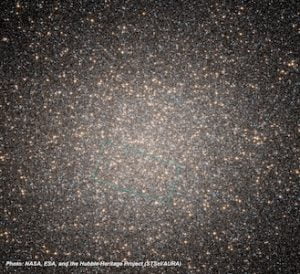
An image of Globular Cluster, Omega Centauri captured by the Hubble Space Telescope.
Image Credit: NASA, ESA, and the Hubble Heritage Project (STScI/AURA).
Globular Clusters are densely populated masses of stars, usually found orbiting the centres of galaxies. These objects can contain hundreds of thousands of stars and until now, those found in our galaxy, were thought to contain stars that formed in a single “burst” event around 10 billion years ago.
In a letter published in this week’s Astrophysical Journal, ICRAR astronomer Dr Kenji Bekki outlines his discovery that the globular clusters we observe today may have evolved from massive “super clusters” in the distant past.
Speaking about his findings Dr Bekki said, “the reason for our way of thinking until now is that we have based our assumptions on the more abundant population of stars that we observe within these objects.”
Using the first 3D computer simulations of massive cluster evolution Dr Bekki’s research shows that globular clusters consist of at least two different populations of stars. Over billions of years the original population of stars that once dominated has been eroded away through “tidal stripping” by the host galaxy.
“By using complex computer simulations we have shown that ordinary globular clusters in our galaxy, the Milky Way, could have been up to 25 times more massive than the objects we see today,” said Dr Bekki.
“These “super clusters” may not be classifiable as “clusters’ at all, because they would once have been as massive as dwarf galaxies.”
This research provides new insight into the formation and evolution of these intriguing objects and provides theoretical explanations for observed physical characteristics of globular clusters.
Dr Kenji Bekki is an astrophysicist with the International Centre for Radio Astronomy Research (ICRAR), a joint venture between Curtin University and The University of Western Australia.

